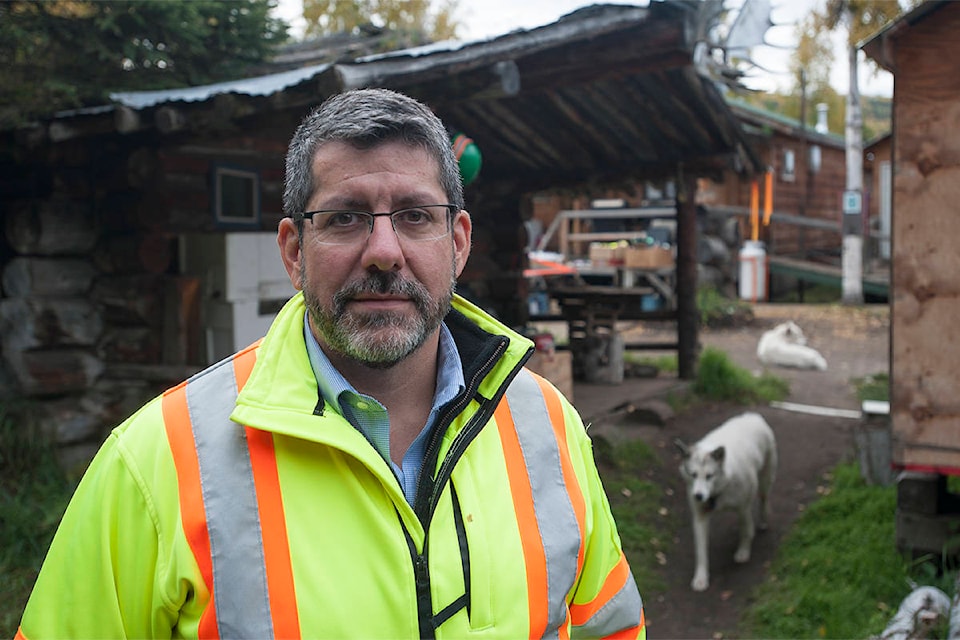About $2.4 billion worth of gold is what Goldcorp, the owner of the proposed Coffee mine, wants to squeeze out of the project, an employee told the News.
Over a 10-year period, the mine, which recently cleared an adequacy stage set by the Yukon Environmental and Socio-economic Assessment Board, will seek to extract two million ounces, said Kelly Constable, social responsibility superintendent.
“Our calculations are based on $1,200 an ounce,” she said.
Constable, along with Coffee’s general manager, Chris Cormier, gave members of the press a behind-the-scenes look at proposed sites on Sept. 11. Over mustard yellow mountains flecked with maroon, Goldcorp flew journalists in a helicopter above the site of potential future facilities, including the camp, waste dump and heap leach pad, the latter of which is the stage where gold is separated from ore using cyanide.
The four sites in which gold deposits are located are aptly named “Kona, Latte, Supremo,” even “Double Double.”
Tr’ondëk Hwëch’in Chief Roberta Joseph was also present for the aerial and ground tour. The First Nation struck an agreement with Goldcorp earlier this year. The project falls 100 per cent within its territory.
To some, the view is like many in the Yukon: stunning. But it’s here that big plans could await, plans over which some have raised concerns.
Currently, the project, about 130 kilometres south of Dawson City, sits at the screening phase, having passed an adequacy step at the executive level, a development that was about two years in the making. To get to this point, Goldcorp was sent back to gather more information after it was found to not have properly consulted with First Nations or provided an adequately detailed package.
YESAB now considers the project has enough to proceed to an environmental assessment.
In May, White River First Nation sent a letter requesting a panel review, the highest tier the territory has to offer.
A YESAB spokesperson told the News earlier this month WRFN’s request is currently being considered.
Don Roberts, chair of Yukoners Concerned, wants a panel review, too. He said more information should be sussed out before the project steams ahead.
“What they want to do is have a heap leach pad that’s one by one kilometers. They want to, over time, put 60 million tonnes of ore and waste rock that will be left in this particular area. They want to cover it, put a pad underneath. (They) say it’ll never leak. Well, that’s impossible,” he said.
Roberts asserted that “in some way” the mine could impact water sources and wildlife, specifically that cyanide, used in the extracting process, may leach out.
“We’d like to see if they’re going to do any type of leaching that it be a enclosed type, in a metal cylinder or in a building that is closed off from any of the elements,” he said.
Roberts said land in and around the area is “pristine” and that sensitive animals like caribou herds inhabit it. The close proximity to creeks and the Yukon River is another concern.
“Everything flows downhill, so if we don’t have (stringent rules) in places before it starts you can sure believe they’re not gonna do it after,” he said.
Asked what would happen if Coffee was put through to a panel review, Cormier, Coffee’s general manager, said he wouldn’t speculate.
The project, he said, as designed and laid out, has been “appropriately assessed.”
“We’ll continue to stand by that. We’re certainly excited to be moving through the public comment period, which we’re in now,” Cormier said.
The deadline of the comment period is Oct. 15.
The heap leach process, which involves cyanide, is a “closed circuit,” he said.
“The water that comes out of that circuit is then treated through a plant and we reuse that water on the pad,” he said, adding that the system would be “state of the art.”
It’s critical, he continued, that it’s contained.
“It’s open to the air, but it’s not open to the environment in the fact water’s leaving that system. Our number one goal is to make sure we’re compliant to all environmental standards,” Cormier said.
Asked what will happen to the cyanide at the end of the mine’s life, Cormier said the heap leach facility would be built in five stages, meaning that, over time, it would be closed accordingly.
“We’ll actually close stages of the pad, which includes rinsing and cleaning and, obviously, water monitoring,” he said. “At some point after we close, we’ll continue to monitor, and, when the water levels are clean, we will close the site, reclaim it and have it signed off by all the proper authorities.”
To a degree, some of the groundwork has already been laid.
Coffee’s “Exploration Camp” was active on Sept. 11. Large, cylindrical tubes packed with minerals were cut, measured, crushed and studied for the presence of gold.
A worker said that on Sept. 11, there were about 75 people on hand. The capacity sits at 80. There’s a smattering of bunkhouses, a mess hall and Goldcorp has contracted a helicopter company.
Constable told the News empty lodgings have started to be moved up the mountain.
Documents assembled by YESAB in relation to the adequacy review say 663 people will be hired for the construction phase and 372 will be hired to operate the mine.
Operations are expected to last about 12 years. Reclamation and closure of the mine, according to documents, will last 11 years.
Contact Julien Gignac at julien.gignac@yukon-news.com
